If you’ve travelled to the tropics of Australia, you’re bound to be familiar with the palm-like Pandanus trees that can be seen growing just inland from the ocean shores. These tropical plants are dioecious trees and shrubs that can make for valuable additions to any warm garden or landscape.
Featuring broad and branching canopies embellished with spiral-like crowns of long green strappy leaves, often striped or variegated, it’s no wonder these trees have become such popular additions to Australian gardens, offering shade, texture and striking tropical silhouettes within outdoor spaces.
Here is everything you need to know to grow and care for these iconic Australian coastal plants.
More...
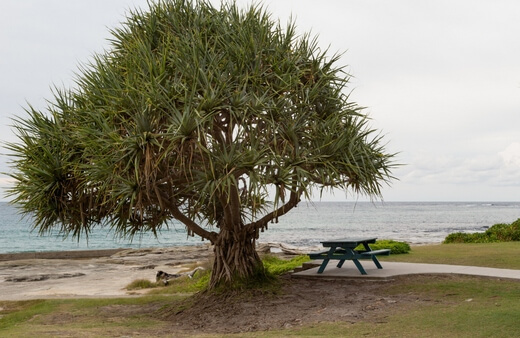
Family: | Pandanaceae |
|---|---|
Genus: | Pandanus |
Species: | Various |
Common Names: | Screw Palm, Screw Pine, Pandanus Palm |
Location: | Outdoors |
Type: | Tree |
Growth: | 4 to 14 metres tall, 3 to 8 metres wide (depending on species) |
Sun requirements: | Full sun to partial shade |
Foliage Colour: | Green |
Flower Colour: | Creamy-green (insignificant) |
Flowering: | Spring to summer |
Fruit: | Females produce decorative pineapple-like fruits after flowering |
Maintenance level: | Low |
Poisonous for pets: | Non-toxic to cats and dogs |
Introducing Pandanus
Apart from the charming tropical foliage, Pandanus also produce stout trunks with attractive stilt roots that offer an architectural appeal as well as support during development. If you live in a tropical or subtropical area, these native species are worthwhile additions.
The Pandanus genus is native to the Old-World tropics and sub-tropics with around 37 species now endemic to Australia where they occur largely along the coastal regions of North Queensland to mid New South Wales. The oldest fossil of the genus was discovered in Queensland, dating back around 30 million years.
Forming a part of the Pandanaceae family, common names now include screw palms, screw pines or pandanus palms. ‘Screw’ refers to some of the trunks which showcase an attractive twisted or spiralled growth pattern.
Preferred climate zones are tropical, subtropical, warm temperate and Mediterranean regions. Frost should be avoided.
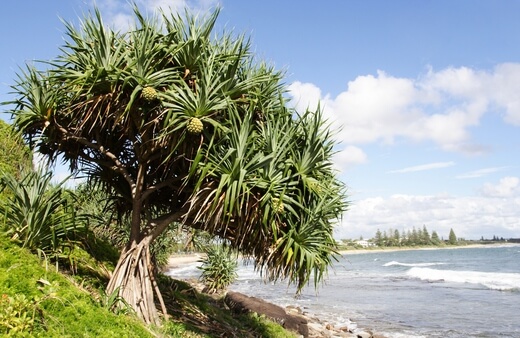
Pandanus Plant Features
Pandanus will typically reach about 4 to 14 metres tall and 3 to 8 metres wide depending on which species you establish. The growth rate is considered slow to moderate in most conditions.
Being dioecious, the plant produces male and female flowers where only females will produce proper fruits. Male fruits are small and fragrant, found in short-lived clusters whereas female fruits resemble large orangey pineapples containing seeds viable for propagation once ripe.Landscaping with Screw Pines
Considered very hardy and adaptable, pandanus palms can offer growers a multitude of landscaping applications within their outdoor spaces. It is good to note that they require sufficient space to grow and spread when grown in the ground so it is advised not to plant near any buildings, paths, drains or other constructions.
The leaves do produce painful spines so always take care when handling the foliage. A decent pair of protective gardening gloves should do wonders.
Common uses for pandanus include:
- Low-maintenance garden feature
- Coastal gardening
- Shade gardening
- Screening or windbreak
- Tropical gardening
- Container gardening
- Native gardening
- Texture and interest
- Traditionally, the leaves were used to weave neck and arm bands, baskets, bags, mats and other helpful craft items.
Popular Australian Pandanus Species
Thatch Screwpine (Pandanus tectorius)A lovely and very popular variegated species that makes for an excellent potted plant that will respond well to being dwarfed. This species is also one of very few in the genus that produces edible fruit. Grown outdoors, this tree will reach around 6 to 9 metres tall and 4 to 9 metres wide. Potted specimens will grow much smaller. |  |
Common Screwpine (Pandanus spiralis)Native to northern Australia, this species can serve as both a shrub or small tree, reaching an expected maximum height of 10 metres in gardens. Its long green leaves form in an attractive spiral arrangement atop the tree's already corkscrewed trunk, making this one of the most ornamental and commonly grown of the natives. | 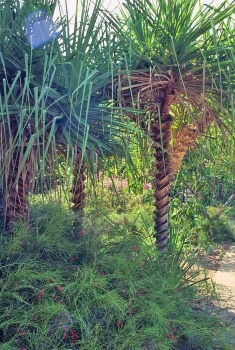 Source: Waltzing Australia |
Cook’s Screw Pine (Pandanus cookii)Sporting a smooth grey bark adorned with crowns of blue-green tapered foliage, this species grows between 6 and 10 metres tall with a spread of 2 to 8 metres. It occurs largely in north-eastern Queensland on beachfront dunes. It is more tolerant to wetter soil types and also produces large decorative orange fruits. | 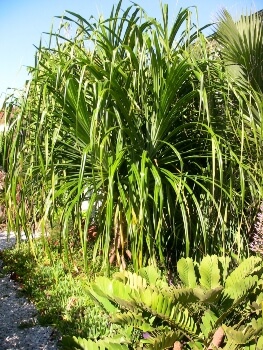 Source: Jerry Coleby-Williams |
Pup Pandanus (Pandanus gemmifer)A tropical rainforest tree with upright, gently arching branches that support lovely tufts of lime-green foliage. This species also produces masses of little off-shoot pups along its trunk that can be twisted off and rooted as cuttings. It grows up to 10 metres tall. | 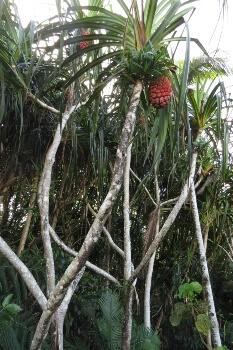 Source: iNaturalist UK |
Water Pandanus (Pandanus aquaticus)This species is slightly smaller, commonly reaching a mature height of about 5 metres. It produces strappy dark-green leaves arranged in striking spirals like many of its counterparts and it will do great potted outside amongst other tropical plants, easily adding interest to any space. |  |
Thatch Screwpine (Pandanus tectorius)

A lovely and very popular variegated species that makes for an excellent potted plant that will respond well to being dwarfed. This species is also one of very few in the genus that produces edible fruit.
Grown outdoors, this tree will reach around 6 to 9 metres tall and 4 to 9 metres wide. Potted specimens will grow much smaller.
Common Screwpine (Pandanus spiralis)

Source: Waltzing Australia


Get Your Free Guide:
Master Growing Australian Natives eBook
A Must Have Complete Guide for Every Australian Garden
Get Your Free Guide:
Master Growing Australian Natives eBook
A Must Have Complete Guide for Every Australian Garden
Native to northern Australia, this species can serve as both a shrub or small tree, reaching an expected maximum height of 10 metres in gardens. Its long green leaves form in an attractive spiral arrangement atop the tree's already corkscrewed trunk, making this one of the most ornamental and commonly grown of the natives.
Cook’s Screw Pine (Pandanus Cookii)

Source: Jerry Coleby-Williams
Sporting a smooth grey bark adorned with crowns of blue-green tapered foliage, this species grows between 6 and 10 metres tall with a spread of 2 to 8 metres. It occurs largely in north-eastern Queensland on beachfront dunes.
It is more tolerant to wetter soil types and also produces large decorative orange fruits.
Pup Pandanus (Pandanus Gemmifer)

Source: iNaturalist UK
A tropical rainforest tree with upright, gently arching branches that support lovely tufts of lime-green foliage. This species also produces masses of little off-shoot pups along its trunk that can be twisted off and rooted as cuttings. It grows up to 10 metres tall.
Water Pandanus (Pandanus Aquaticus )

This species is slightly smaller, commonly reaching a mature height of about 5 metres. It produces strappy dark-green leaves arranged in striking spirals like many of its counterparts and it will do great potted outside amongst other tropical plants, easily adding interest to any space.
How to Grow Pandanus
Common propagation methods can vary depending on which species you grow but usually, you can propagate these species using fresh seeds (known as keys) or by rooting healthy plant cuttings.
Seeds and cuttings should be started in spring to summer once conditions are warm. Alternatively, young and healthy nursery plants are readily available. These tubestock plants will establish themselves faster and with less effort on your part.

Ways to Propagate Pandanus
Pandanus Propagation Using Seeds
- Once the fruits turn orangey-red, they should be ripe (this could take up to a year).
- Collect the fruit pods for fresh seed keys from within the woody capsules. Allow them to dry a little before sowing.
- Sow the large keys into individual containers filled with a quality propagation potting mix. Avoid over-compressing the soil.
- Place seeds firmly into the soil surface, allowing the tops to stick out slightly.
- Water well and place in a warm and sunny location free from frost.
- Keep the soil moist while the seedlings develop. Reduce watering in winter.
- Germination can take up to 12 months.
Propagating Pandanus Using Cuttings
- Using a pruning saw or sheers, take a healthy stem or branch cutting of at least 15 cm in length.
- You can also cut away a stilt root cutting from the base of the tree if you prefer, this should root well too.
- Prepare a large container filled with moist, well-draining soil.
- Place the cutting into the soil and backfill until firmly positioned.
- Water it well and place it in a warm, sunny location away from strong winds.
- Maintain healthy soil moisture as the cutting develops.
Tips for Growing Screw Pines in Pots
You can grow your screw pines in containers outdoors to effectively dwarf them, leaving you with a smaller specimen you can enjoy for many years.
Here are a few helpful tips:
- Use well-draining containers filled with rich, peat-based potting soil
- Position the plants in a sunny location with plenty of warmth and humidity
- Fertilise throughout the growing season
- Move potted plants indoors if you live in colder climates with winter frost
- Container-grown plants will require more frequent pruning to maintain their smaller size.
- Repot every 2 to 3 years or as necessary to maintain a dwarf growth habit. Repot into fresh soil and remember your protective gloves.
Best Conditions for Planting Pandanus
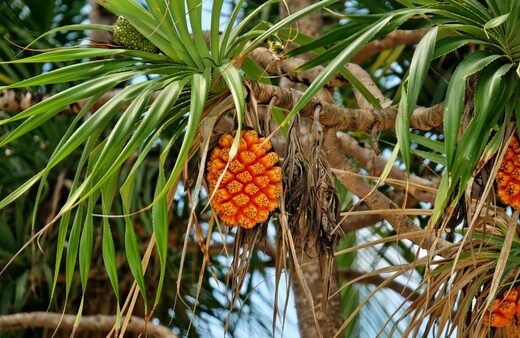
Once established, screw pines will be tolerant to drought, strong winds and salt spray. However, they are very sensitive to frost so those who live in cooler regions should consider growing indoors for the best results.
Overall, these species showcase great adaptability to our endemic conditions as long as your climate is favourable. Here are some of the basic growing conditions that will allow your pandanus to thrive as well as some care tips to keep it looking its best.
Sunlight
These tropical plants perform their best in sunny positions with a little shade during hot afternoons. Though they can tolerate partial shade, growth can be slower in shadier conditions.
Soil
Most soil types should be suitable for screw palms, including sandy or poorer soil types as long as your soil is well-draining. Soggy soil should be avoided as much as possible.
Temperature and Humidity
Endemic to the tropics, these plants naturally grow well in warm, sunny and humid environments. Preferred temperatures should be above 15°C with limited exposure to colder environments. Medium to high humidity in the correct climate zones should be perfect.
Watering
Keep well-watered over the summer to prevent the foliage from burning in the heat. Preferred annual rainfall is between 1,500 and 4,000mm. It is recommended to water weekly only when rainfall is not sufficient. Watering should be reduced significantly in winter to avoid rot.
Fertilising
These trees require regular feeding during the active growing seasons between spring and early summer to promote strong, healthy growth. Feed with a well-balanced organic garden fertiliser or a native plant fertiliser about 2 to 4 times in spring.
Light supplemental feeding can be done occasionally thereafter as needed until winter when the plant reaches dormancy.
How to Prune Pandanus
After flowering, prune to remove any damaged and dead branches or stems. Trimming away old foliage will ensure the plant receives an equal distribution of light and ventilation which will assist with healthy growth and denser crowns.
Light additional pruning to maintain shape and tidiness can be performed as needed. Remember to wear protective gardening gloves when dealing with spiny foliage.
Pests and Diseases to Watch Out For
There are few reported pest or disease issues when growing pandanus in suburban gardens. If your plant is kept cold and wet for too long, it could suffer from dieback but should come back next spring with some extra care.
Mealybugs and aphids could also pose a minor threat but infestations can easily be controlled using horticultural sprays or insecticides. Refer to our guide on how to get rid of aphids for more info.
Pandanus Frequently Asked Questions

How fast does pandanus grow?
The growth rate is considered slow to moderate, typically only 2 to 80 cm per year depending on the growing conditions.
Does pandanus need a lot of water?
These tropical trees don’t mind lots of water in summer but be sure to dramatically reduce watering in winter as they can readily rot.
Does pandanus grow in shade?
Some species can tolerate more shade than others, but generally, planting in sunny to partially shaded locations is best.
Is pandanus an air purifier?
Yes, when grown indoors the plant can help purify the air and increase humidity.
What is the lifespan of pandanus?
Established plants can typically live for about 50 to 80 years. In perfect conditions, these trees can even live for over 100 years.
Which pandanus are edible?
P. Amaryllifolius and P. Tectorius are known to produce fruit safe for human consumption.
What is the difference between pandan and pandanus?
Pandan is the common name of the edible species P. Amaryllifolius whereas pandanus refers to the entire genus of plants.
Perk Up Your Gardens Tropical Presence with Pandanus
Tough and very adaptable, pandanus plants are excellent picks for those who live in warm areas looking for an ornamental and striking tropical tree to establish in their landscapes.
The palm-like foliage and gently spiralling crowns can look fantastic in any outdoor setting, offering shade and some showiness to boot. There are many beautiful native and introduced species to choose from ranging in size and form so you’re bound to find the perfect pandanus for your gardening needs, big or small.
Published on February 18, 2023 by Lorri Hopkins
Last Updated on September 19, 2025




